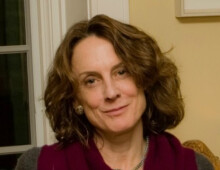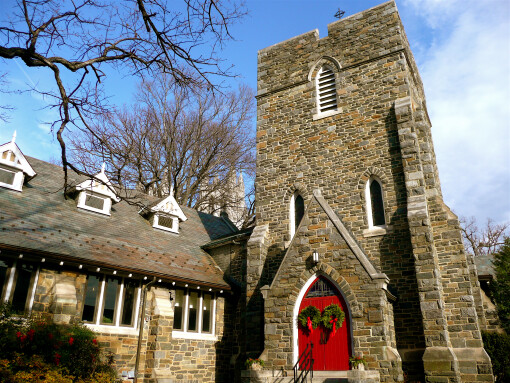I Saw Satan Falling Like Lightning

Series: Pentecost
Speaker: Diana Gustafson
Now may the meditation of my heart and the words of my mouth be acceptable in your sight, my rock and my redeemer. Amen.
I have been looking for an emoticon -- one of the little symbols, like smiley faces, used in emails -- that represents laughing and crying at the same time. I want to find an emoticon that signifies what the character Bottom in A Midsummer Night’s Dream calls “tragical mirth.” It should capture that sense of experiencing something so sad it is unbearable until someone makes a joke about it and then you laugh too hard. That’s what happened when I first saw the front of this week’s New Yorker Magazine. The cover is a watercolor drawing of Monty Python’s John Cleese in a bowler hat doing a Silly Walk. You remember this sketch from the Monty Python Show in the 1970s? Except in this case, the English Civil Servant, as portrayed by Cleese, is silly-walking right off the Cliffs of Dover. Britain in voting to leave the EU, this suggests, has silly-walked itself headlong over the edge, into a pit of ethnic vitriol and economic chaos.
There is some evil afoot in the West as citizens of Britain, Shakespeare’s “sceptered isle,” spit on their Muslim neighbors and post street-signs declaring “No more Polish Vermin.” This feels all wrong. For better or worse, the United Kingdom is a country I was brought up to revere. It is the country that fought the long, lonely fight against Hitler in World War Two. It is the Britain of winged playwrights, soaring cathedrals, and hallowed rock ‘n roll bands. And now, in the Twenty-First Century, it is the England where many are driven by fear and loathing. You could say England represents any of us when Evil creeps close.
We watched in horror this week the terrorist bombings in Turkey and Bangladesh. Across much of Europe and the United States as well, we are reeling from eruptions of violence and hatred. Fifty men and women were gunned down at a gay nightclub in Orlando three Sundays ago by an American claiming allegiance to Islamic terrorists.
Four weeks ago my husband, Tom, and I flew into Istanbul for a ten-day study tour. The first thing we saw when we arrived at the airport was a colorful kiosk that sells shelf-upon-shelf of candy and rows of pink, yellow and brown stuffed animals. Above the display of animals and sweets is the store’s name: JOY SHOP. The naïve bluntness of this is endearing: is joy so simply obtained? But it is not far from this little purveyor of happiness that dozens of tourists were murdered last week.
For Tom and me, Istanbul was a portal into a different world. Many things looked familiar – there were street signs in English and Starbucks Coffee shops everywhere. But despite Istanbul’s recent history as an aggressively secular city, it is difficult to avoid signs of human faith in the divine. Minarets punctuate the skyline like exclamation points. Young university women walk to class with colorful headscarves twined round their faces.
Faith is visible and high-decibel. Across the street from our hotel was the Prince Mosque, a towering house of prayer whose domes turn blue in the early dawn. Islamic prayer is a loudly public business, and I wore earplugs to bed to soften the 4 am call to prayer that blasted from the mosque next door. Even the cabinet drawer above our hotel minibar – this was the irony of faith expressed in a secular society – held a sign with an arrow pointing toward Mecca, so observant Muslims would know which way to address their prayers.
Turkey is a country of contradictions: joy and violence, secular and divine, good and -- evil. Turkey was like the emoticon I’ve been looking for: Happy Sad --- Tragical Mirthful --- Joy Pain. Evil and goodness coexist.
Here in the US we often want to be happy all the time. We like smiley face emoticons. We think of evil as something outside ourselves. As in Britain, we hear calls for the building of walls at the borders and airports. In my pastoral work, I have met parents -- African American, Latino and Muslim -- who tell me their anxious children beg them to move north to Canada where they hope they will be safe.
If only evil were easy to avoid. In today’s world, we cannot run by crossing a border. We cannot hide behind walls. Evil is around us. We must see it, we must name it, we must find the strength to address it. God offers us that strength and guidance.
Satan is not part of our 21st century pantheon of spiritual beings. We embrace love, generosity, even vulnerability as Christian virtues. We see a force for good, a force for compassion and generosity in others – in Doctors without Borders, for example. These qualities are the essence of divinity embodied in Christ. But we have a harder time acknowledging Evil. We squirm a little at the thought that Evil might be a Noun as well as an Adjective.
Perhaps in our daily lives we acknowledge Evil’s existence -- but not in ourselves. Maybe I am a little impatient, irritable, we say to ourselves as we sit in our cars, but I’m not evil. Evil isn’t wishing the man jabbering on his cell phone and driving 50 miles an hour in front of me on 495 would suddenly explode. Right? Evil is only shooting people up in a café. Isn’t it? But Evil lives in that seed watered on 495. Recognize it in yourself. And then ask yourself instead, how is that person in front of me suffering? Everyone you meet is suffering from a tragedy you know nothing about.
It is difficult to recognize that the thing that moves us and our fellows toward mean-spiritedness, hatred, and even violence could be a force. A force, the way there is a force for Good. Or that this force might have a concrete and fully-formed being in something called Satan or Evil.
But this is how Jesus talks about evil. His world is full of demons.
The seventy sent out by Jesus to proclaim the coming Kingdom of God in today’s Gospel find demons and report, with joy, that “in your name even the demons submit to us.” Jesus responds that he “watched Satan fall from the heaven like a flash of lightening.” He has given the seventy power over the enemy. But that is not the main thing. Zapping demons is cool, but not the point. “Do not rejoice at this, that the sprits submit to you,” he says, “but rejoice that your names are written in heaven.”
Jesus is asking us in this morning’s gospel to step through another portal, into a new world that is the Kingdom of God. To enter this world, we must seek joy, even where there is violence, see the divine amidst the secular, search out the evil that is in others and within ourselves, so that we might bring God’s love to the parched and hungry. If the portal is blocked and we react with hatred and violence – if like John and James in last week’s reading, we firebomb the Samaritans who reject us and whose otherness we fear – we will not reap the harvest God has sown.
To reveal the Kingdom of God we walk through a portal, over the debris of violence, to a new world of radical welcome and vulnerability. Entering this Kingdom requires many of the skills of the traveler. We look for welcome – a taste of God’s Kingdom – and we extend peace. To the seventy sent out, Jesus says, “When you enter a [stranger’s] house, first say ‘Peace to this house.’” Stay at that house, he says – do not move around from stranger to stranger – until you have shared their days with them – until you know their names. Until you know your own name, as a person of Peace and Welcome.
We enter this new world almost naked. ‘You will be like lambs among wolves,’ Jesus says. You will have none of the accoutrement of daily living that like walls at the border keep uncomfortable experiences at bay. Leave behind your purses, your sandals. Be vulnerable and be strong to the good and evil you meet.
Our portal to a new way of being in the world comes here, today, as Jesus sends us out with the 70 to do his work. This new way of being is one of welcome even amid fear – of compassion amid violence – of naming who we are and naming our brothers and sisters as Children of God -- when everyone else is jumping off the cliff of hatred. Jesus asks us to turn toward Jerusalem – recognizing the hatred and fear that linger there at the place of the crucifixion, but moving on toward the Kingdom of God.
AMEN
Seventh Sunday after Pentecost
St. Alban’s Church, Washington, D.C.
2 Kings 5:1-14; Galatians 6: 1-15; Luke 10: 11-1, 16-20
 Welcome to St. Alban’s Church! Every Sunday, and most days in between, people gather in this place to worship, to learn, to grow, to share the joys and struggles of our lives, and to seek God’s grace in the midst of our lives. We do not come because we have it all figured out, but because we are seeking light on the way. We come as we are and welcome one another.
Welcome to St. Alban’s Church! Every Sunday, and most days in between, people gather in this place to worship, to learn, to grow, to share the joys and struggles of our lives, and to seek God’s grace in the midst of our lives. We do not come because we have it all figured out, but because we are seeking light on the way. We come as we are and welcome one another.

